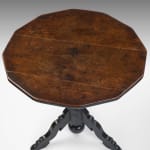17th Century Oak Tripod Table
ENGLAND, CIRCA 1670
67.5 x 66 x 65 cm
26 ½ x 26 x 25 ½ in
26 ½ x 26 x 25 ½ in
7063
Further images
The dodecagonal top comprised of three planks, the single baluster support turned with with ring decoration and three bold bosses, the top supported on three scroll-cut sections shaped from a...
The dodecagonal top comprised of three planks, the single baluster support turned with with ring decoration and three bold bosses, the top supported on three scroll-cut sections shaped from a flat board and tenoned into the central column, supported on similar down-swept legs.
Chinnery writes: 'Domestic inventories are peppered with a wide assortment of small tables and stands, few of which have survived, owing to the vulnerability of such small and inexpensive items of furniture. After the middle of the seventeenth century, they begin to appear in increasing numbers and varieties. Some were made by turners...but many were joiner-made with elaborate turned decoration....The earliest of these [small pedestal] tables (1640-1720) have their legs shaped from a flat board and tenoned into the base of the stem...but in later examples the leg is a full compound curve related to the cabriole leg.' (Victor Chinnery, Oak Furniture The British Tradition', Antique Collectors' Club, 1979, p. 296.
Chinnery writes: 'Domestic inventories are peppered with a wide assortment of small tables and stands, few of which have survived, owing to the vulnerability of such small and inexpensive items of furniture. After the middle of the seventeenth century, they begin to appear in increasing numbers and varieties. Some were made by turners...but many were joiner-made with elaborate turned decoration....The earliest of these [small pedestal] tables (1640-1720) have their legs shaped from a flat board and tenoned into the base of the stem...but in later examples the leg is a full compound curve related to the cabriole leg.' (Victor Chinnery, Oak Furniture The British Tradition', Antique Collectors' Club, 1979, p. 296.






